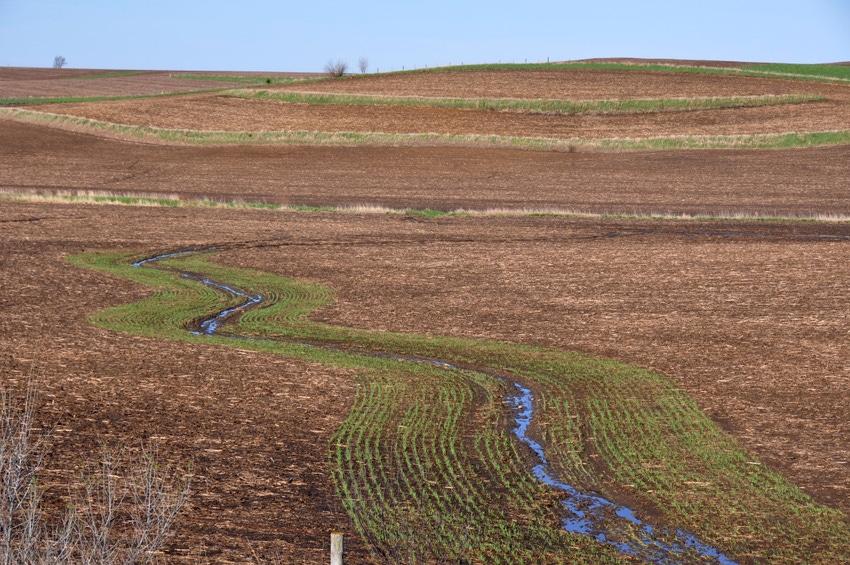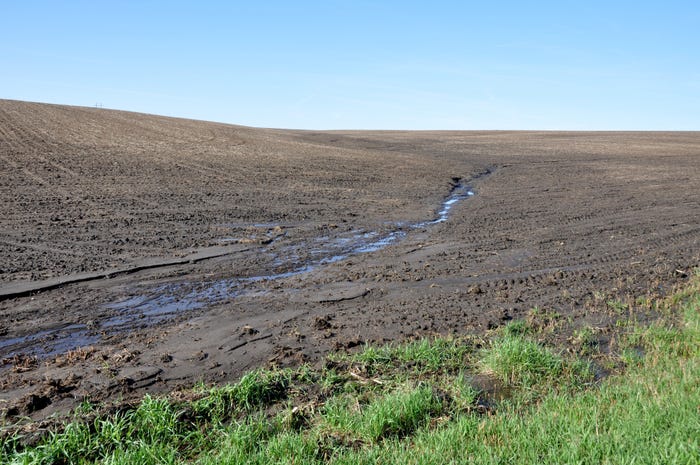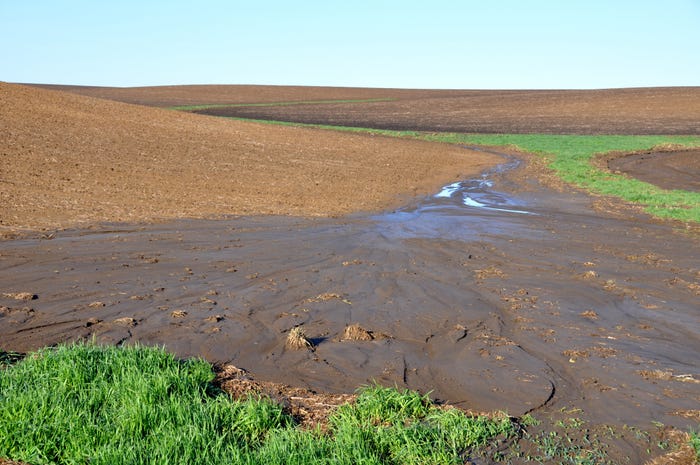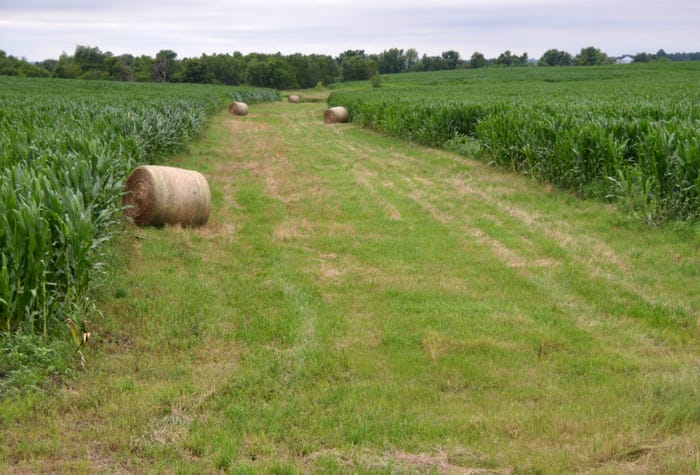June 15, 2018

Think Different
Grassed waterways and field borders are areas of the field put to grass because they are either severely eroding or have the potential to erode. But a protective grass cover isn’t the end of the story, though since they are everchanging. How you farm around them means everything in how long they will last and effectively serve their purpose.
-------------
Grassed waterways may not be as old as the hills they’re established in, but they’ve been around long enough to qualify as a “senior” conservation practice. For decades, they’ve been used to safely transport runoff water from a field via natural field drainageways, where the grass cover protects the soil as water rushes over it, at times a foot deep or more.

Grass will lie down as water will run down the center of this well-maintained waterway to keep it functioning.
“May and June often bring the strongest, most erosive rainfalls of the year, at the time of year the soil in many fields has been loosened with tillage and there’s no crop canopy for protection,” says Dan Paulsen, acting state resource conservationist for the USDA Natural Resources Conservation Service in Iowa. “It’s the time of year—after a strong thunderstorm—you can readily see how well a grassed waterway is or isn’t working. And it’s a great time to identify other areas in the field with new ‘ephemeral’ gullies that could benefit from protective grass cover.”
Crop rows must lead into waterways
Some say the only thing worse than not having a grass waterway is having one where water funnels alongside one or both sides of the waterway, in the crop field instead of at the center of the waterway. “You get either one or two new gullies at the edge of the waterway when that happens, and you’ve taken land out of production for no good reason,” Paulsen says.

Waterways are well suited to natural depressions in the landscape where water concentrates to run off fields. This area can continue to be filled in and tilled, but it will continue to erode and cause issues for machinery to cross. A grass waterway from the top of the slope to the bottom would prevent gullies from forming in the field.
A likely reason water funnels alongside the waterway is the waterway is treated as the edge of the field, with crop rows are planted parallel to the waterway. That guides water alongside instead of into the waterway. “It’s pretty common to see end rows planted along a grassed waterway, but that works against getting the runoff into the waterway, the whole reason you have the waterway,” Paulsen says. “What you want to do is plant the rows so each row feeds water into the waterway. The rows are on the contour and the waterway is up and down hill. So the rows feed into the waterway on more of a perpendicular angle. If you run planting equipment a foot or two into the waterway, that will help guide the water there.”
Removed or missing waterways
It upsets long time Taylor County, Iowa farmer and conservationist Kelly Tobin to see gullies in field draws where there should be waterways, or fields with eroding waterways caused by crop row patterns that don’t guide runoff into the waterway correctly. “I suppose I started with waterways 50 years ago. I’m particular that the crop rows don’t go up and down the sides of the waterways, and it bothers me to see up and down hill farming as I drive across the state,” Tobin says.

Most of the sediment at the bottom of this field came from both edges of the waterway—runoff water either never got into the waterway or jumped out of the waterway.
Now in his last year as a farm manager for Hertz Farm Management, he’s also worked with both tenants and landowners over the years to emphasize the benefits from farming correctly to extend the life and functions of grassed waterways. “You can raise the planter to go across waterways instead of planting up and down hill alongside them,” Tobin says, “and you have automatic shutoffs on sprayers that you can program to protect the grasses in them. You just have to want to do it.”
Tobin has a mix of corn, soybeans, CRP, alfalfa, and 20,000 trees on his 740-acre farm. It’s protected with terraces, no-till and cover crops with waterways in place where they’re needed. Tobin says his waterways work better now than they did back in the day when fields were tilled and had no cover crops. “We’ve adjusted our terraces to fit 24 row equipment,” he says. “Both the terraces and waterways work better with no-till and cover crops. We’re building our soil quality. As we’ve improved from 2% organic matter to 3% and 4%, there’s so much better water infiltration and water holding capacity that the terraces and waterways don’t have to handle as much water.”
Adapt farm to more frequent severe storms
Climatologists say in the past 10 years spring storms have been both stronger and more frequent. That means more erosive stress in areas where water flows off fields, with more reason for grassed waterways and complementary practices that make them easier to maintain. Since waterways are constantly filling or cutting anyway, more storms mean more inspection and likely more maintenance to keep water flowing down the center without excessive gullying or filling with sediment.
“Both no-till and cover crops help reduce sheet and rill erosion in the field itself. The bonus to using those practices is that by keeping soil in place and encouraging more rainfall to infiltrate the soil where it falls, waterways function better. There’s not as much runoff force with less water in the waterway, and not as much sediment in the water to drop out at the edge of the waterway or to build up in the center in waterways that are used in flatter landscapes,” Paulsen says.
Use grass headlands in sloped fields
Similar to planting rows parallel to a waterway, a contradiction in conservation that stands out to conservationists is seeing headlands used with end rows right beside them. “A farmer is doing a good job of stopping erosion on a steep slope at the edge of a contoured field by using a grass field border as a turn strip,” Paulsen says. “That grass turn strip is meant to eliminate up and down hill end rows. But when you see instances of up and down hill end rows being planted adjacent to a field border on land that’s every bit as steep, all that’s done is move the erosion problem into the field a little farther. The grass at the edge of the field is good for wildlife, but the end rows defeat the purpose of a field border that’s meant to eliminate up and down hill farming.”
Tobin has seen the up and down hill end rows, too. “I think maybe the existing field borders aren’t wide enough to turn their large equipment on, so they plant the end rows up and down hill,” Tobin says. “I think they know better, but they still do it.”
Waterway maintenance tips
Waterways are built with a parabolic shape that guides water to the center. In steep terrain, or in cases when downpours come before grass can become established, gullies can also form in the center of new waterways. It’s not uncommon for sections of a waterway to become a gully in the center that needs to be reshaped and reseeded.

It’s a good idea to bale and remove vegetation every two years to keep water moving through the waterway.
Management and maintenance tips for keeping waterways in shape include:
When spraying, shut the sprayer off before crossing the waterway to maintain good grass cover.
You can lead water into the waterway with implements like a planter, but lift them out of the ground before crossing the waterway.
If the grass cover is diminished, be sure these areas are reseeded and that grass is reestablished as quickly as possible.
Since mature grasses trap sediment, and can eventually force runoff outside the waterway, mow to preserve a shallow, bowl shape. Allow for bird nesting by mowing before May 10 and after July 15.
If water falls from one level to another at the outlet of a waterway, such as a road ditch, consider constructing an outlet structure.
Beware of driving on wet waterways—tire tracks can start gullies.
Be conscious of the waterway’s boundary. It’s easy to creep into the waterway edge with field equipment each year, losing width and ability of the waterway to do its job.
Incentives available
In addition to technical assistance, NRCS provides financial assistance for installing grassed waterways through the Environmental Quality Incentives Program. In Iowa, financial assistance is also available from Iowa Department of Agriculture and Land Stewardship’s Division of Soil Conservation and the continuous Conservation Reserve Program, administered by USDA’s Farm Service Agency. Check with your local NRCS office.
To get more information about incentives available for establishing waterways on your farm or technical assistance in designing them, visit your local NRCS or conservation district office. There is also a good deal of information online, including:
Detailed information on grassed waterway design from Chapter 7, part 650 of the NRCS Engineering Field Handbook at
https://directives.sc.egov.usda.gov/OpenNonWebContent.aspx?content=17766.wba
Good information from the Illinois Drainage Guide at:
http://www.wq.illinois.edu/dg/grass.htm
And, an NRCS Fact Sheet at:
https://www.nrcs.usda.gov/Internet/FSE_DOCUMENTS/nrcs142p2_007306.pdf
About the Author(s)
You May Also Like




